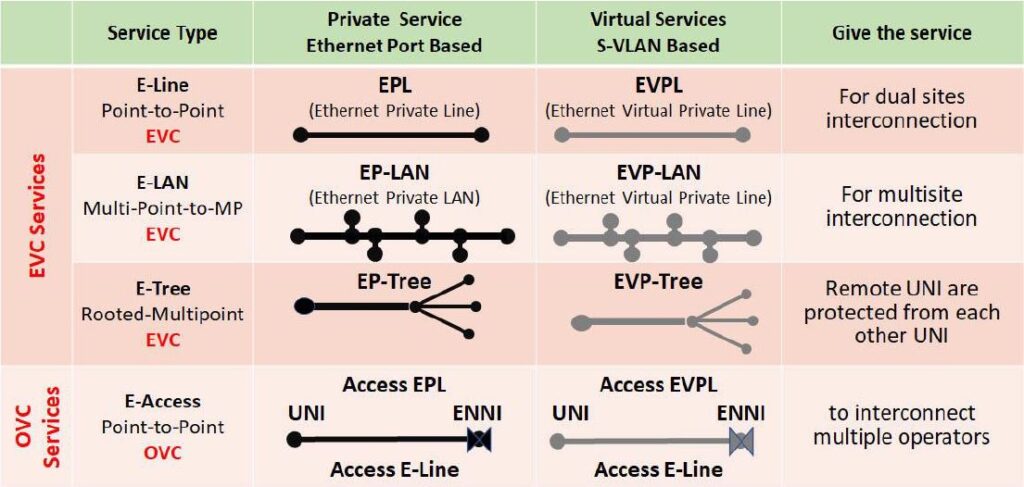CARRIER ETNERNET
Carrier Ethernet, a PTN Transport Technology
A little slice of history: The Ethernet was defined as IEEE802.3 in 1973 to organize the LAN inside the site of small to large companies. At this period, many LAN technologies such as Token-Ring and ARCNet were in development or were deployed with more or less success.
The Ethernet definition includes the PHYsical Layer 1 (10Baset-T, 10Mbps/ twisted pair) and Layer 2 of Data Link with MAC with control (Media Access Control). The Ethernet was invented for short-distance LAN with bridge and switch. The request to accommodate a different group of users in the same LAN created the interest to tag and drive these communications of groups. In 1999, the IEEE defined the VLAN 802.1Q that facilitates easily identified access and switch to dedicated resources. This was also the year when the Spanning Tree Protocol was defined as IEEE 802.1D to support the connection of two networks with Bridge. But many issues such as packet looping, or packet broadcasting arose because of the independent traffic in each network. Generally, to connect two distant networks, we would use one router at each external connection over Leased Line (LL) E1/T1 or serial. This isolates both networks, and the eventual Telco/Carrier provides the leased line. Public Carrier or internal IT organizations have started to propose Ethernet connections between sites. But they must be out of each independent LAN and prove the stability of Ethernet pipe as LL.
In 2006 came the definition of the Provider Bridges IEEE 802.1ad, or Q-in-Q, the dual/triple VLAN tagging or S-VLAN which allows the multipoint transport between sites of the customer traffic and their C-VLANs. This makes it easy to share many S-VLANs in the same large pipe if we apply OAM. Instead of multiplying the fibers with protection, local Carriers or multisite enterprises or a group of activities in the MAN area as Town Technical Services can deploy a secured Carrier Ethernet GE/10GE network and provide the transport of services from many actors/customers and manage their QoS in MAN area. For Carriers, this solution has rapidly replaced the LL with an aggregation router at less cost and higher bandwidth optimization. But this transport is limited to the MAN without long-distance solutions and the number of services limited to 4096.
In 2008 the IEEE validated the Provider Backbone Bridge 802.1ah or Mac-in-Mac for an unlimited Ethernet network of transportation. But it is designed for TELCO and thus it is not in Loop Telecom’s target.
MEF and CE 1.0/2.0/3.0: In 2001 the Metro Ethernet Forum MEF was created with the mission to structure the Ethernet transport WAN with the service based on Port or virtual port or C/S-VLAN and to develop the tools to manage the bandwidth as OAM. 2006 MEF CE 1.0 and then 2012 CE 2.0 have been published and defined as follows:
- Each user access is a UNI, and each link between 2 or more UNIs is a Point-to-Point or Multipoint Ethernet Virtual Connection EVC Based service
- Per-EVC QoS, Policing and Shaping for Service Isolation and Traffic Engineering
- The Ethernet service interconnection E-Line, E-LAN, E-Tree, E-Access
In 2019 CE3.0 includes all and adds the Operator Virtual Connection (OVC) Service to interconnect multiple operators of transport by ENNI and many other definitions including the SDN and NVF solutions of integration.
Loop Telecom proposes a range of EDGE devices, including the AM3440-E-CHEB and the Aggregation, 10GE Backbone, NIDs Concentrator G7820, G7860A and PTN10G that support CE 2.0 services.

VLAN features: The Loop Telecom EDGE devices support full VLAN features to create EVC as Q-in-Q (C-VLAN, S-VLAN), MAC or port. To optimize the transport, these EDGE devices provide the Layer 3 routing of VLAN.
Protection: Based on port and EVC, the EDGEs and Concentrators support not only RSTP, MSTP and Link Aggregation but also the ITU-T ERPS with Ring and Subring, which gives the possibility to deploy no-single-point-of-failure mandatory in many infrastructures such as Railway.
QoS: This is a key point of warranty for the private or carrier transport network relating to each customer. With eight hardware priority queues, the NIDs build the QoS Per-EVC, then per subscriber. The Traffic Engineering Engine provides Strict Priority and Weighted Round-Robin Scheduling, with fixed rates for services such as TDM-PseudoWire transport and Rate limiting per EVC.
OAM Operation, Administration and Maintenance: The OAM makes it possible to manage stable transport. Thanks to Link Layer Discovery Protocol (LLDP), Connection Fault Management (CFM), Ethernet First Mile (EFM), ITU-T Y.1731, Y.1564 Performance and Service Activation Test, the operators of transport networks can manage at End points and Intermediate points by the EDGEs and Concentrators.
The OAM is used for mixed infrastructures as Carrier Ethernet at the EDGE and MPLS-TP at the core and gives command of the protection.

Time and Frequency Synchronization: EDGE devices and Concentrators transport and distribute the Synchronization along with the Network to UNI for industrial applications, TDM PseudoWire transport or IP-Nodes. The frequency synchronization is achieved by using SyncE GE with SSM message of quality. The Phase or Timing synchronization is achieved by using the PTP 1588v2 protocol that supports Ordinary, Boundary or End-to-End Transparent Clock for industrial automation.
The OAM gives the possibility to manage stable transport thanks to Link Layer Discovery Protocol (LLDP) and Connection Fault Management.
Secure Access: NIDs include a high level of security at UNI and NNI ports. They support Radius servers based on single or multiple IEEE 802.1X with VLAN and QoS assignment per authentication. Port authentication can be MAC-Based or multiple ACLs role of Filtering and Policing.
Carrier Ethernet NIDs and Concentrator Router/MPLS-TP: Loop Telecom proposes the integrated solution with full Carrier Ethernet or a mix of infrastructure with Layer 3 router to provide VRRP for redundant server access or long-distance infrastructure with MPLS-TP in the Core.
All ranges of devices are supported by our EMS iNET that helps with the deployment and monitoring.
